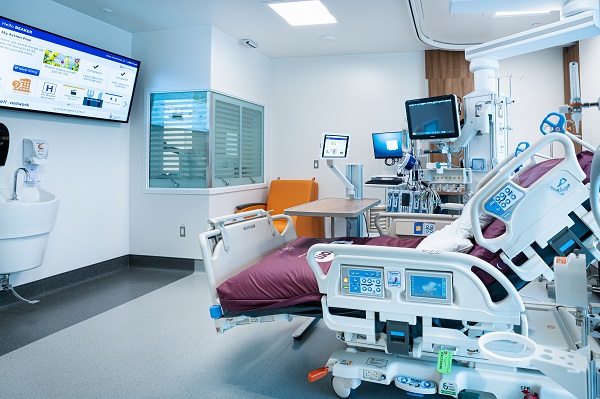By Vaso Charitsis
After a long workday, John, 60, begins to feel unwell while exercising. He is dizzy, has trouble speaking and calls an ambulance. The first responders notice signs of a stroke and transport him to the hospital. At the hospital, John is admitted and is placed in a smart bed. The bed’s weighing and monitoring functions are activated, and the information is transmitted to his electronic health record (EHR). His care team now has accurate data to determine the precise dosage for the life-saving medication he needs. Administering the right dosage as quickly as possible increases his chance of recovery.
After he is stabilized, John is moved to the integrated stroke unit where he can call for assistance from his care team using the speaker on his smart bed. Even though his speech may still be impaired and he still has difficulty moving around, John is able to use a MyCare bedside tablet to order his meals, lower the blinds in his room and watch TV.
As John begins his recovery journey, his physician and health care team create a personalized treatment plan that includes educational videos and medications that can be viewed on his MyCare tablet. For the first time in a month, John begins to feel much better and feels he’s ready to go to the bathroom on his own. He tries to get up from his bed, but an alarm goes off alerting “please do not exit your bed,” as he can be at risk of falling. His health care team is automatically alerted through their smart mobile devices and because John’s wristband tracks his location, staff and physicians know exactly where he is. Ultimately, the team can support and prevent him from having a potential fall.
Once John returns home and attends an appointment with his primary care physician, he can log in to his MyChart account from his mobile device to view details of his hospital stay. This includes test results and prescribed medications, and John can share those details with his family doctor for his follow-up visits.
John’s story is just one example of how smart technology can improve patient experience and outcomes. At both of Mackenzie Health’s hospitals, Mackenzie Richmond Hill Hospital and Cortellucci Vaughan Hospital, Canada’s first fully smart hospital, these smart technologies have been integrated to anticipate the needs of patients and health care providers. Smart technology improves patient health and wellbeing, gives patients control of their health needs and allows the care team to spend more time with patients. Smart technology enables seamless access to patient health records, enhanced quality of patient care and improved flow of information across departments and hospital sites.
“Above all, the investments we have made in smart technologies at Mackenzie Health is all part of the quadruple aim of improving the patient experience, the provider experience, improving clinical outcomes and reducing overall costs,” says Altaf Stationwala, President and CEO, Mackenzie Health. “Leveraging smart innovative technological systems and medical devices that can speak to each other means staff and physicians have more time to spend taking care of patients.”
While digital technology has existed for some time, smart technology takes digitization one step further. “Ultimately, smart technology becomes a virtual member of the care team, helping the clinical team foresee what comes next in a patient’s health care journey,” says Dr. Aviv Gladman, Chief Information Officer, Chief Medical Information Officer and ICU physician. “Our patients, staff and physicians interact with technology every day, creating what we refer to as digital moments of health. For patients, it means more control, increased convenience and better outcomes. For the health care team, it means spending less time doing non-value-added tasks such as filling out paperwork, locating equipment and gathering information from multiple places.”
The digital moment of health is a key component of Mackenzie Health’s smart vision. “By capitalizing on the flow of information, we create intelligent digital interactions that enrich the patient’s experience and improve patient safety and quality of care,” says Gladman. “When we link smart technologies, we create an Internet of Healthcare Things (IOHT[i]) with boundless opportunities.”
As part of Mackenzie Health’s innovation journey, the organization also established the Mackenzie Innovation Institute (Mi²) in 2015, to help guide the organization’s transformation journey for innovative health care delivery. Over the subsequent years, strategic partnerships with industry leaders such as Philips, Sodexo, Hillrom, CenTrak as well as academic institutions such as York University have been established.
“What makes Mi² unique is our approach to private-public partnership models with industry leaders who are equally driven to co-develop and implement first-of-kind smart solutions that will provide the best care and patient experience at Mackenzie Health,” says Stationwala. “The long-term objective is that the projects started at Mi² and evaluated at Mackenzie Health can become a blueprint for other health care providers.”
With a mission to relentlessly improve care to create healthier communities, Makenzie Health is determined to continue to identify innovative smart technologies that can more effectively solve health care problems in Ontario and beyond.
Vaso Charitsis is a Senior Communications Consultant at Mackenzie Health.




